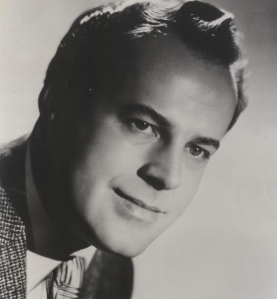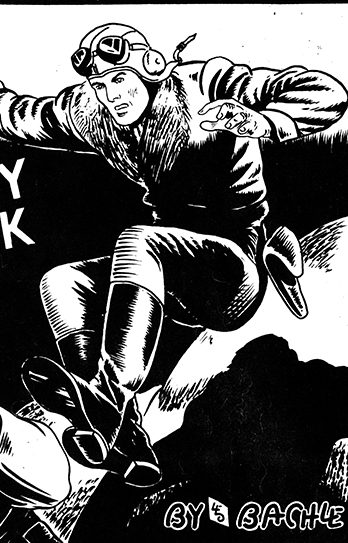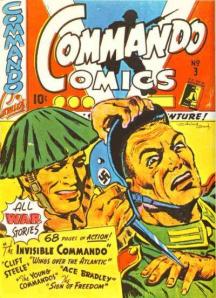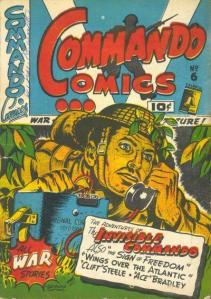
In celebration of the Johnny Canuck Kickstarter Campaign to reprint! Support before it’s too late!
Throughout 1941, Canadian comic book readers experienced a boom in Canadian produced comics. It wasn’t until late in that year that Johnny Canuck was slated to appear.
In December of 1940, American luxury goods (including comics) were forced out of the Canadian market. Without the heroes that Canadian children had come to know and love like Batman and Superman, Canadian publishers got a clear shot to produce Canadian ones. Foremost of these heroes was none other than Canada’s answer to Captain America, Johnny Canuck.
 Johnny originally appeared in the first issue of Dime comics, which likely appeared on news stands in late December 1941 or January 1942, but whose publication date is February. Johnny’s creator, Leo Bachle, was just 16 at the time he created the comic for Cy Bell and John Ezrin. Despite Bachle’s youth, Johnny Canuck would go on to be one of Bell Feature’s biggest characters, and indeed, one of the biggest and most lasting characters of the Golden Age. The comic itself is just over 230 pages of comics spread across 28 issues and 7 arcs. The first and last issue are the only issues to be one shots.
Johnny originally appeared in the first issue of Dime comics, which likely appeared on news stands in late December 1941 or January 1942, but whose publication date is February. Johnny’s creator, Leo Bachle, was just 16 at the time he created the comic for Cy Bell and John Ezrin. Despite Bachle’s youth, Johnny Canuck would go on to be one of Bell Feature’s biggest characters, and indeed, one of the biggest and most lasting characters of the Golden Age. The comic itself is just over 230 pages of comics spread across 28 issues and 7 arcs. The first and last issue are the only issues to be one shots.
Although Leo Bachle created the character and worked on the comic for most of the series, he left Johnny Canuck and Bell Features to take a position in New York. Subsequently, Johnny was handled by Andre Kulbach from issue 24 to 27, and Paul Dak took the last issue.
 Johnny’s character was kind of a Jack of all trades, a flying ace and fighter, secret agent, and officer in the Canadian military. Most of the time, Johnny was saving “foreign beauties” and fought the axis on almost every war front. He met up with Hitler no fewer than three times and was trained in trapeze and boxing! Throughout his comics he travelled to Yugoslavia, Russia, Germany, Libya, Tibet, and China. It wasn’t until the final issue that Johnny’s story took place in Canada, and just off the coast of Halifax! Interestingly, this story also had a science fiction feel, as this last comic took place after the end of the war, and essentially, after Johnny’s biggest villain was out of the picture!
Johnny’s character was kind of a Jack of all trades, a flying ace and fighter, secret agent, and officer in the Canadian military. Most of the time, Johnny was saving “foreign beauties” and fought the axis on almost every war front. He met up with Hitler no fewer than three times and was trained in trapeze and boxing! Throughout his comics he travelled to Yugoslavia, Russia, Germany, Libya, Tibet, and China. It wasn’t until the final issue that Johnny’s story took place in Canada, and just off the coast of Halifax! Interestingly, this story also had a science fiction feel, as this last comic took place after the end of the war, and essentially, after Johnny’s biggest villain was out of the picture!
Recently, like Nelvana of the Northern Lights, I’ve been privileged with the position of collecting, restoring, and publishing Johnny Canuck! It’s never been reprinted in the seventy years since the last issue hit the rack! But I need your help! I’m raising the funds through kickstarter, a crowd funding website! Preorder the book here and get all kinds of other cool stuff like prints, posters and even original art by some of todays top creators! Let’s read Johnny’s adventures again!

 Bell Features, the truest of Canadian Golden Age comics published several titles during the 40’s including the aforementioned Active Comics.
Bell Features, the truest of Canadian Golden Age comics published several titles during the 40’s including the aforementioned Active Comics. Like Active Comics, Commando Comics was themed, and in this case, based heavily on combat, war, secret missions, the Axis, and really, all other things commando. This theme was common during the war as it fueled nationalism and support and provided a more realistic hero. Active comics’ had Dixon of the Mounted, The Brain, Thunderfist, Active Jim and Captain Red Thorton which all featured daring action adventure stories. Likewise, Commando Comics had The Young Commandos, The Sign of Freedom, Wings Over the Atlantic, The Invisible Commando, Ace Bradley and Clift Steele. These stories shared a similar theme and formula which is evident in the cover pages pictured, and produced a very tight comic. This consistency lasted until about issue #15 when some of the more regular titles began to slowly drop off.
Like Active Comics, Commando Comics was themed, and in this case, based heavily on combat, war, secret missions, the Axis, and really, all other things commando. This theme was common during the war as it fueled nationalism and support and provided a more realistic hero. Active comics’ had Dixon of the Mounted, The Brain, Thunderfist, Active Jim and Captain Red Thorton which all featured daring action adventure stories. Likewise, Commando Comics had The Young Commandos, The Sign of Freedom, Wings Over the Atlantic, The Invisible Commando, Ace Bradley and Clift Steele. These stories shared a similar theme and formula which is evident in the cover pages pictured, and produced a very tight comic. This consistency lasted until about issue #15 when some of the more regular titles began to slowly drop off. It wasn’t really a surprise when Bell Features again began changing their lineup. Slowly, almost all of the above titles were phased out and replaced with gag comics or funnies by Robert Young, Thomas, Frank Keith, Harry Brunt and Hy Moyer. For stories they started using titles like the Polka Dot Pirate (A female avenger of sorts), Ruff and Reddy, Mr. Distracted Attorney, Salty Lane (Secret Investigator), Dick Stone, Chick Tucker and Flame Berns. There was even a Doc Stearne thrown in there. Beyond the obvious ridiculousness of the characters, the comic became unrecognizable to its former self.
It wasn’t really a surprise when Bell Features again began changing their lineup. Slowly, almost all of the above titles were phased out and replaced with gag comics or funnies by Robert Young, Thomas, Frank Keith, Harry Brunt and Hy Moyer. For stories they started using titles like the Polka Dot Pirate (A female avenger of sorts), Ruff and Reddy, Mr. Distracted Attorney, Salty Lane (Secret Investigator), Dick Stone, Chick Tucker and Flame Berns. There was even a Doc Stearne thrown in there. Beyond the obvious ridiculousness of the characters, the comic became unrecognizable to its former self.